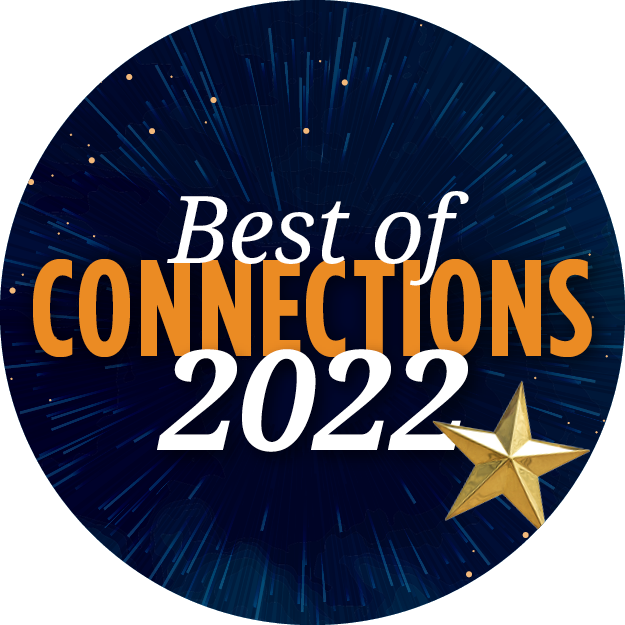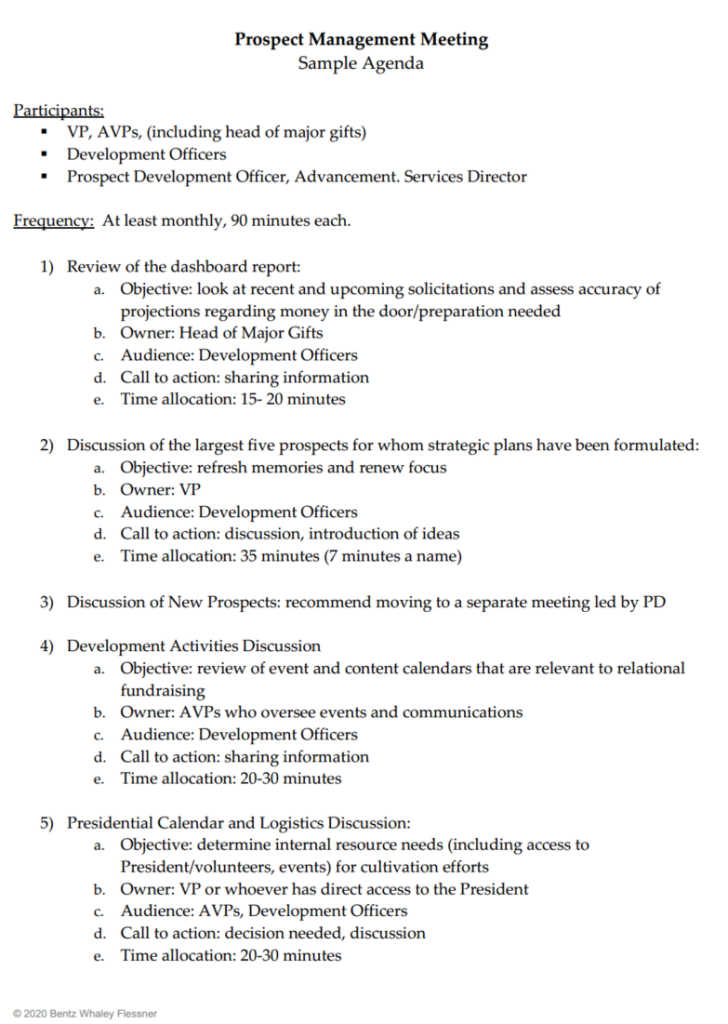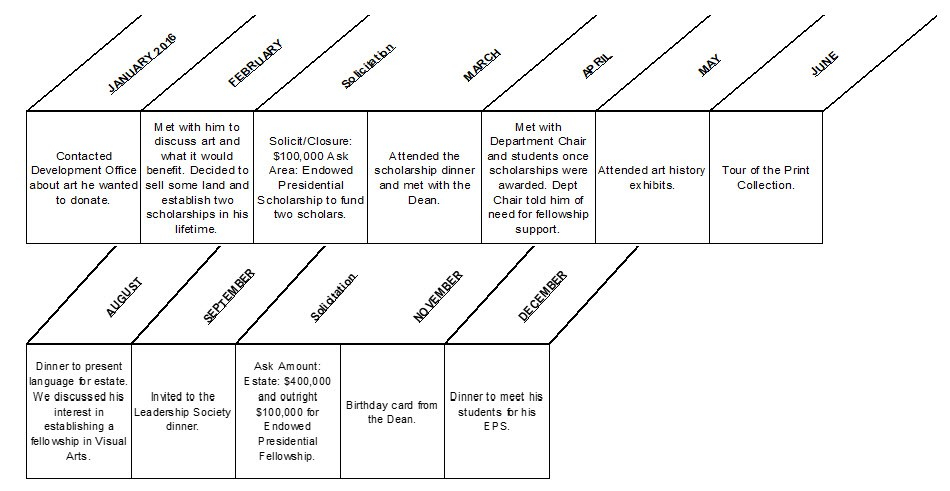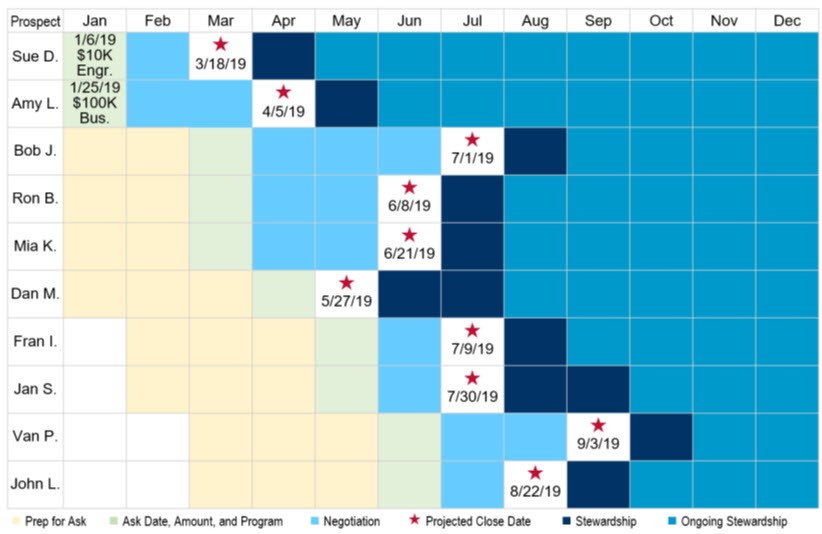Prospect Research · Best of Connections
Meetings That Matter: Driving Fundraising Success Through Deliberate Planning
By Bond Lammey and Jacqui Coones | January 20, 2022

Editor's Note: This article is featured in Best of Connections 2022. Read the editor's message to learn more about the top articles of the year.
Like many nonprofits, Missouri State struggled to realign business processes in the pandemic when all work shifted to remote. Gift officers struggled to secure conversations with significant prospects, and more internal planning was required to ensure these gift conversations were set up for successful outcomes. Rather than working harder, we focused on identifying ways for them to work smarter.

Identifying the Problem
BWF and Missouri State engaged in monthly prospect development coaching conversations specifically for issues like this. Our discussion started by determining challenges for gift officers and leadership. At that point, Missouri State had the following standard meetings:
- Once a month, the vice president facilitated individual meetings with each gift officer, which also included the executive director of development and director of prospect management and research, to discuss new and closed proposals.
- Biweekly, prospect management and research facilitated individual meetings with gift officers to discuss moves management, list composition, proposal updates and list maintenance activities.
Internal meetings were being used to report out on current challenges, successes and opportunities. However, even if a gift officer wanted to brainstorm strategic ideas for closing a proposal, the monthly meeting was not structured appropriately to have these discussions with leadership.
Ideally, we wanted meetings to include objectives and expectations of participants, while also incorporating enough flexibility to allow participants to brainstorm and problem solve together.
Meeting Inventory
One thing that can be helpful in reimagining your approach toward meetings is to conduct an inventory of current meetings, working off the agenda for each one. If your meeting doesn’t have a standard agenda, start by retroactively creating one from meeting notes. The example below is a good starting point for an exercise that you can replicate for an agenda at your organization.

Let’s say this is an agenda for a meeting that you and/or your team attend with gift officers. The head of major gifts feels that these meetings lack focus and has asked for your input on the agenda.
For each topic area, outline the following:
- Objective: What is the desired outcome or purpose of including this topic on the agenda?
- Owner: Who is setting the context or leading the discussion?
- Audience: Who are the desired participants in this conversation?
- Call to action: Sharing information, decision needed, discussion, introducing idea.
- Time allocation: How much time should be spent on this topic?
Once you’ve completed this exercise on your own, take a look at the example below to see how the article’s authors completed it.

Solutions and New Meeting Schedule
Missouri State utilized the meeting inventory exercise as a starting point to reimagine development meetings. The exercise made it clear that gift officers needed a forum to collaborate and brainstorm ideas on how to further engage prospects who are temporized. Furthermore, they needed the opportunity to visit with leadership about proposals and certain prospects. Lastly, there should be a meeting solely focused on the solicitation cycle.
As a result, prospect management and research suggested a new meeting schedule that involved a different meeting for each month of the quarter (see below).

The quarterly meeting is with each gift officer, the vice president of advancement, executive director of development, and the director of prospect management and research. The meeting provides a snapshot of the gift officer’s performance, including highlights of the gift officer’s recent achievements, while also providing a forum to discuss methods to overcome potential roadblocks to success.
The second meeting within a quarter is a brainstorming meeting. Throughout 2020, one of the most common concerns from gift officers was the lack of team building events and chances to collaborate. Taking this into consideration, brainstorming meetings were developed with gift officers as the focus. The other meetings allow leadership the ability to lend support and assistance to ensure the gift officers meet their goals.
was created as a safe space for gift officers to be vulnerable and share their work struggles. Each gift officer submits a solicitation plan of their choice to discuss with the group. The director of prospect management and research facilitates the discussion, but it is mainly a time for the gift officers to support one another and provide feedback and ideas to one another. Gift officers have stated that these are their favorite meetings. In addition, it has helped with morale of the team.
The last meeting of the quarter is a solicitation meeting with each gift officer, executive director of development and director of prospect management and research. In this meeting, the gift officer is asked to discuss current open proposals, as well as future proposals. Proposals have been added to the old database after the ask; however, the new CRM allows us to add proposals proactively to help with solicitation mapping.
Solicitation Mapping
A side effect of adopting a disciplined approach to internal planning meetings is that it likely will create a trickle-down effect in terms of the need to maintain efficiencies in portfolio management. Many organizations are moving toward an expectation that fundraisers must have a personalized plan for every name in their portfolio that includes the actions they will take to ensure these prospects become active, lifelong philanthropic supporters of your institution. Ideally, that plan should lead to a solicitation within the next 12–24 months for at least 50% of their portfolio (some organizations have shifted to only including prospects with planned solicitations in their portfolio).
The other 50% may either be in assessment or stewardship phases, and a solicitation could be planned for up to 36 months out. Regardless of timeline, every individual should be assigned a plan including daily, monthly and quarterly activities designed to guide individuals in making the largest possible contribution to your institution. The following graphics may be helpful in determining how best to think about partnering with your frontline colleagues to organize their work, prospect-by-prospect.

Above: Monthly solicitation planning for single prospect

Above: Monthly solicitation planning for top prospects in portfolio
Conclusion
Taking the time to assess and analyze the current state of meetings can lead to creative agendas that keep staff engaged and focused. The meeting inventory exercise is something that Missouri State intends to go through annually to ensure meetings are making positive contributions to the department. If you have questions, please feel free to contact Bond at BLammey@BWF.com or Jacqui at JacquiCoones@MissouriState.edu.
